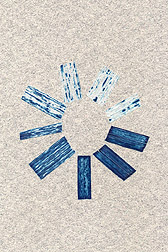Wheat Streak Mosaic Virus: From Harmful to Helpful
|
||
|
Wheat streak mosaic virus (WSMV) is little more than a genetic snippet of ribonucleic acid. But for the Northern Great Plains, outbreaks of this rogue RNA molecule in winter wheat can mean big losses.
Now, Agricultural Research Service and University of Nebraska researchers are seeking to unravel the virus' biology and use that knowledge to fight it. ARS plant pathologist Drake C. Stenger says wheat curl mites carrying WSMV can transmit it to wheat plants through feeding. Once inside, invading viruses force their host's cells to obey genetic instructions for assembling new viral copies. When WSMV infects winter wheat in the fall, the result can be catastrophic. A 1995 outbreak, for example, cost Montana's wheat industry nearly $35 million in losses. But now the virus is actually doing some good for a change—at least in the laboratory. Stenger's team has decoded WSMV's entire genome, revealing all 9,384 chemical letters, or nucleotides, comprising its RNA alphabet. This feat has enabled them to harness the virus as a vector, or a molecular "taxi," for delivering foreign genes into the tissues of grown wheat plants. "We've taken advantage of the virus's natural talent for expressing its own genetic material in plants," explains Stenger, at ARS' Wheat, Sorghum, and Forage Research Unit, Lincoln, Nebraska. "We've turned the virus into a powerful genetic tool," adds colleague ARS plant pathologist Roy C. French. "The virus is most useful in discovering and identifying what particular genes might do, and it offers a way of getting those genes into wheat more quickly than by conventional transformation." For now, the scientists are outfitting the virus with two new genes for bacterial enzymes. Both genes are easily detected in plants by use of a chemical test or a blue stain. Either method offers visible evidence the virus is expressing its borrowed genes as it replicates and spreads among cells. This knowledge may reveal new ways of engineering wheat plants so that they block crucial proteins the virus needs in order to multiply. The team's approach, reported inThe Plant Journal, vol. 23, pp. 547-555 (August 2000), should be faster than introducing new genes by inserting them first into a callus. A callus is a mass of plant cells from which whole plants can be regrown. Now, instead of waiting 6 to 9 months to begin evaluating such plants, scientists can do so in 4 to 5 days by inoculating whole plants with the gene-bearing virus. Says French, "Many labs are identifying gene sequences for wheat, rice, and other cereals. Often, we have little or no idea what these genes do. With our virus gene vector, however, we can insert genes for known proteins and quickly see how they behave in the plant." Eventually, commercial wheat breeders will be able to adapt the approach to provide growers with new varieties modified for better disease resistance or other improved traits.—By Jan Suszkiw, Agricultural Research Service Information Staff. This research is part of Plant Diseases, an ARS National Program (#303) described on the World Wide Web at http://www.nps.ars.usda.gov. Drake C. Stenger and Roy C. French are in the Wheat, Sorghum, and Forage Research Unit, 334 Keim Hall, University of Nebraska, Lincoln, NE 68583; phone (402) 472-2710 [Stenger], (402) 472-3166 [French], fax (402) 472-4020. |
|
|
"Wheat Streak Mosaic Virus: From Harmful to Helpful" was published in the December 2000 issue of Agricultural Research magazine. |
||







